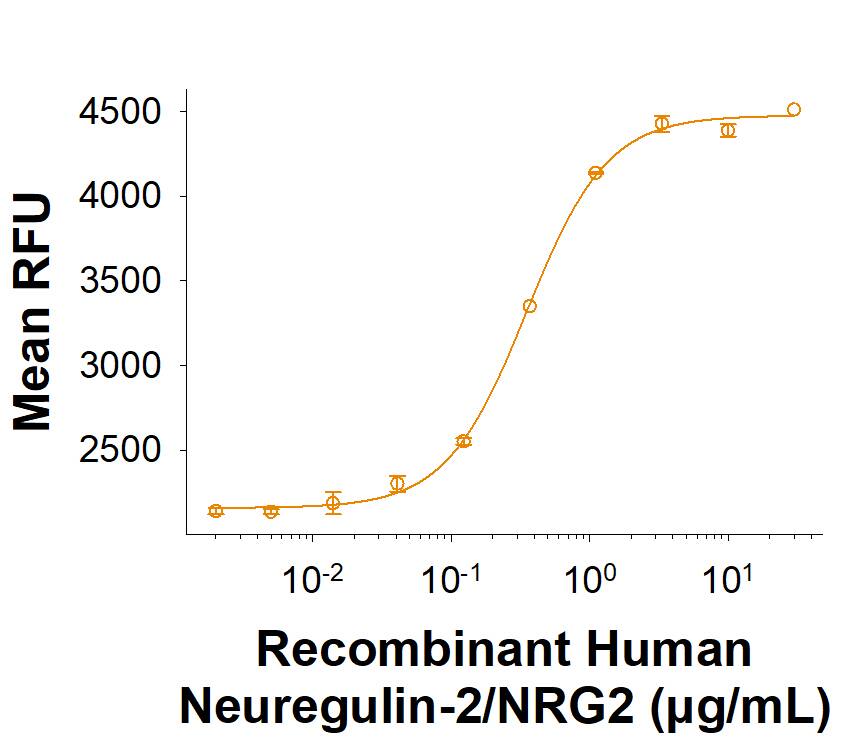Recombinant Human Neuregulin-2/NRG2 His-tag Protein, CF
R&D Systems, part of Bio-Techne | Catalog # 11355-NR

Key Product Details
Product Specifications
Source
Chinese Hamster Ovary cell line, CHO-derived human Neuregulin-2/NRG2 protein
Cys112-Lys404, with a C-terminal 6-His tag
Cys112-Lys404, with a C-terminal 6-His tag
Purity
>95%, by SDS-PAGE visualized with Silver Staining and quantitative densitometry by Coomassie® Blue Staining.
Endotoxin Level
<0.10 EU per 1 μg of the protein by the LAL method.
N-terminal Sequence Analysis
Cys112
Predicted Molecular Mass
34 kDa
SDS-PAGE
41-51 kDa, under reducing conditions.
Activity
Measured in a serum-free cell proliferation assay using MCF-7 human breast cancer cells. Karey, K.P. et al. (1988) Cancer Research 48:4083.
The ED50 for this effect is 0.100-1.00 μg/mL.
The ED50 for this effect is 0.100-1.00 μg/mL.
Scientific Data Images for Recombinant Human Neuregulin-2/NRG2 His-tag Protein, CF
Recombinant Human Neuregulin‑2/NRG2 His-tag Protein Bioactivity.
Recombinant Human Neuregulin‑2/NRG2 His-tag Protein (Catalog # 11355-NR) induces MCF‑7 human breast cancer cell proliferation. The ED50 for this effect is 0.100-1.00 μg/mLRecombinant Human Neuregulin‑2/NRG2 His-tag Protein SDS-PAGE.
2 μg/lane of Recombinant Human Neuregulin‑2/NRG2 His-tag Protein (Catalog # 11355-NR) was resolved with SDS-PAGE under reducing (R) and non-reducing (NR) conditions and visualized by Coomassie® Blue staining, showing bands at 41-51 kDa.Formulation, Preparation and Storage
11355-NR
| Formulation | Lyophilized from a 0.2 μm filtered solution in PBS with Trehalose. |
| Reconstitution | Reconstitute at 500 μg/mL in PBS. |
| Shipping | The product is shipped at ambient temperature. Upon receipt, store it immediately at the temperature recommended below. |
| Stability & Storage | Use a manual defrost freezer and avoid repeated freeze-thaw cycles.
|
Background: Neuregulin-2/NRG2
References
- Nagasaka, M. and S-H.I. Ou (2022) Trends Cancer 8:242.
- Ou, G-Y., et al. (2021) Front. Aging Neurosci. 13:662474.
- Carraway, K.L. et al. (1997) Nature 387:512.
- Higashiyama, S. et al. (1997) J. Biochem. 122:675.
- Bublil, E. M., and Y. Yarden (2007) Curr. Opin. Cell Biol. 19:124.
- Nakano N., et al. (2016) Neurosci. Lett. 622:88.
- Meyer, D., et al. (1997) Development 124:3575.
- Yang, L. et al. (2022) Am. J. Cancer Res. 12:2173.
- Centa, A. et al. (2018) Mol. Oncol. 12:1061.
Alternate Names
Don-1, Neuregulin2, NRG2, NTAK
Gene Symbol
NRG2
UniProt
Additional Neuregulin-2/NRG2 Products
Product Documents for Recombinant Human Neuregulin-2/NRG2 His-tag Protein, CF
Product Specific Notices for Recombinant Human Neuregulin-2/NRG2 His-tag Protein, CF
For research use only
